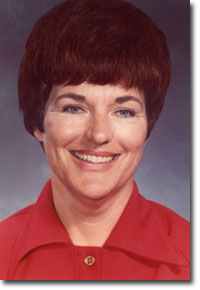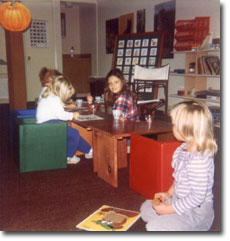|

Joan Larimore, circa 1958

Lisa, a 2nd grader, leads two Ks in
their YAK Phonics lesson. A visiting 4-year-old listens intently.
(Side bar: Her sister, one of the two in the photo, taught her to
read at home using her YAK worksheets!)
Re: the pictures
Looking at the few photos I selected,
you can see what a variety of learning experiences went on at any
given time.
MI is absolutely the only way a teacher can expose the
children to so much in such a short year.
It creates an atmosphere
where individuals or small groups can work on areas of interest and
ultimately, the human entity being a curious creature, every child
knew what every other child was doing!
So there were always children
learning a special thing in depth and others, with less interest in
that area(s), gained a nodding acquaintance with many fields of
study. So much for the hefty tomes of curriculum at each grade level
which dictates what a child can learn and what is “forbidden” until
next year!
Joan Larimore
|
|
Joan
Larimore is an educator who, in the 26th
year of her thirty-year teaching career, began using the Mutual Instruction, "family-style" methodology. This was in
the late 1970s in the Culver City, California public school system.
In 2010, having just read The Plainston Chronicles, Joan wrote a series of
letters to the author, Dr. E.M. "Mac" Swengel, which in themselves
are an amazing testimony to the workability of this classroom
approach, not to mention a glimpse into the heart and soul of this
extraordinary teacher.
June 6, 2010
Dear Mac,
MI [Mutual Instruction] will be of increasing importance as the
economy strips education of even more funding. Not that most of the
crap that has been funded is any good! So much for No Child Left
Behind! My contention, for many, many years, has been that throwing
money at our school problems is not the answer. And what is the
answer? Throw that money at excellence in teacher training. As
always, the key is the teacher and the use she/he makes of the
intelligence of children. Therein lies the key; trust more in
children and their innate ability to discover the “right” way
despite the stumbling stones we adults drop in their paths.
The year that I truly put MI into practice was Marlene’s last year
at Washington School when we no longer had classroom aides. I had 36
K-1-2- babies, limited supplies, and limited teacher time. Out of
sheer desperation it was necessary to turn much of the classroom
activity over to the children. And who could, with minimal training,
run the class better? Those children, of course! Regardless, I got
what I wanted and needed; time to work with individuals! And
naturally, just as in Plainston’s one-room schoolhouse, discipline
problems dissolved, children exceeded expectation, and as a teacher,
I felt I was finally doing what I was born to.
The first time I truly felt I was accomplishing my set goals was
when the children, after six weeks of YAK Phonics, began to
scoff at the preprimary and primer reading books of the state
adopted series. Comments? “That’s baby!” Believe it or not, the
school librarian almost denied me the more advanced books I wanted
to check out for the class! Thank God for Marlene who told her I was
to have whatever I felt appropriate for the group. These were the
children who delighted in learning to speak, read, and spell five
and six syllable words which they had learned from the many charts
we made of our discussions. Oh, how children love BIG words! When I
finally sent two K babies to the library to read third grade books
to the librarian, she was a convert! Was it a rigged situation?
Hardly, as she picked the books!
My sense of MI, or whatever a person chooses to call it, is only
truly appreciated once a teacher has experienced it with a classroom
full of learners and developed it WITH the children as opposed to
individually imposing it upon them. Educators can read about this
miracle and nod and say, “Sure! Sounds great, but it won’t work for
most teachers.” But the key is that it will work for anyone to
whatever degree the teacher is willing to give up her/his solo spot
in front of the class! What I find amusing is that once you give up
that traditional role, you find yourself, as the teacher, far more
in charge than you ever dreamed possible! Well, right from the
start, I was a “good” teacher; why did it take me so long to
discover that I really could be an “excellent” educator? A true
educator! A person who guided children into positive learning
patterns. Perhaps, Mac, that is what most of us, as teachers, never
discovered. You don’t really teach anyone anything! You simply guide
them to discovery on their own! What a concept! And isn’t that the
key to everything? We can internalize what we learn on our own while
we ignore, cast aside, or scorn most of what we are “taught.”
Perhaps one of the important keys to “teacher training” is to toss
out the current vocabulary and begin speaking in true “educational”
language. As long as we cling to the word “teacher,” we will
restrict our thinking!
Plainston’s Grace is so correct when she has doubts about MI. How
many people are willing to give up “classroom control”? Dear God,
there are actually university courses in classroom control! Do you
think there is any hope of the current economy forcing us back into
the one-room schoolhouse?
What a pleasure, Mac, to be able to get on my soapbox with you and
say what I actually feel about education. To have another person who
truly understands is such a relief. Boy, am I weary of the
glassy-eyed stares of teachers who haven’t the foggiest notion of
what I’m speaking about!!
So there you go, Mac. There is a light at the end of the tunnel and
hopefully we’ll both live to see it. Otherwise, I’ll be forced to
“return” for another lifetime of education. Do you think I’ll be any
smarter next time around?
|



